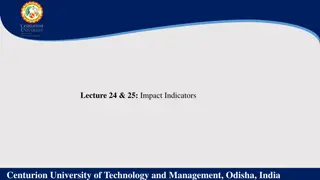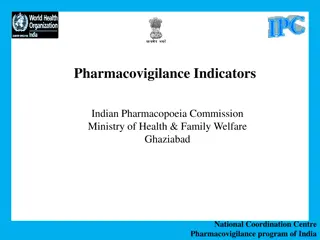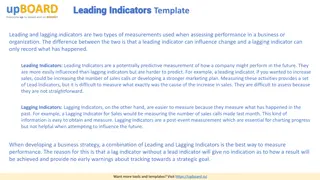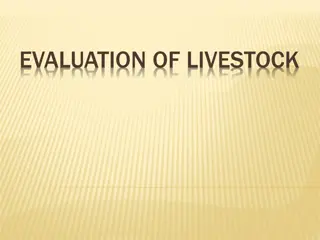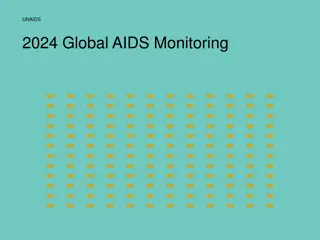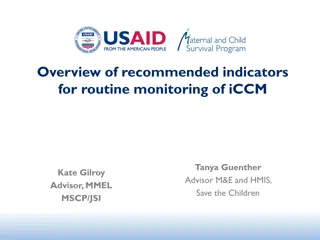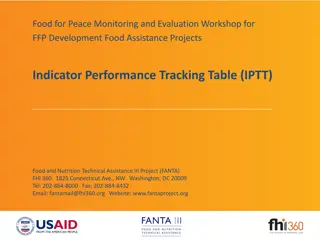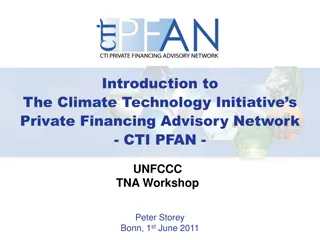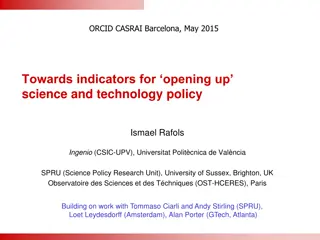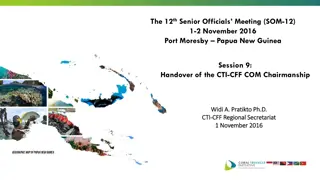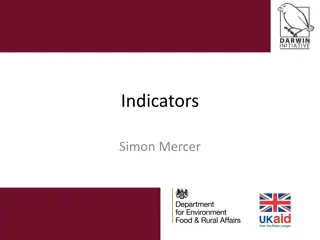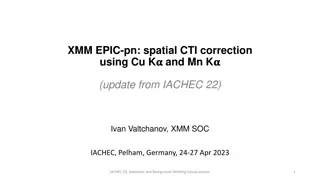CTI-CFF Monitoring and Evaluation System: S.M.A.R.T. Indicators Overview
The CTI-CFF Monitoring and Evaluation System utilizes S.M.A.R.T. Indicators to track progress in achieving marine conservation goals. It includes workshops and meetings, roles, reporting, and accountability structures, as well as types of indicators focusing on funding, capacity building, and marine sanctuary establishment. The system aims to establish and manage marine protected areas effectively for food security and economic benefits to coastal communities.
Download Presentation

Please find below an Image/Link to download the presentation.
The content on the website is provided AS IS for your information and personal use only. It may not be sold, licensed, or shared on other websites without obtaining consent from the author.If you encounter any issues during the download, it is possible that the publisher has removed the file from their server.
You are allowed to download the files provided on this website for personal or commercial use, subject to the condition that they are used lawfully. All files are the property of their respective owners.
The content on the website is provided AS IS for your information and personal use only. It may not be sold, licensed, or shared on other websites without obtaining consent from the author.
E N D
Presentation Transcript
CTI-CFF Monitoring and Evaluation System and S.M.A.R.T. Indicators Alan White, Ph.D. Chief of Party USAID Sustainable Ecosystems Advanced (SEA) Project, Indonesia July 9-10, 2020 Photo CTSP/James Morgan
2008: M&E WG Workshops and Meetings CCC 1, Jakarta (May) CCC 2, Manila (October) SOM 2, Manila (October) 2009: SOM 3, Port Moresby (March) SOM 4, Kota Kinabalu 2010: SOM 6, Manado 2011: SOM 7, Jakarta 2012: Workshops, Manila & Jakarta SOM 8, Jakarta April 2013: Workshop, Manila (M&E Manual development)
The M&E System in place Roles, Reporting and Accountability
Types of Indicators INPUT Resource: Funding and capacity building PROCESS Action 4: Establish and enforce additional marine sanctuaries (no-take zones) OUTPUT Intermediate result: Region- wide Coral Triangle MPA system in place and fully functional OUTCOME Result: Marine protected areas established and effectively managed and critical habitats protected and productive in support of fisheries IMPACT Food Security and economic benefits to coastal communities
Impact: Improvement in the affordability, availability and quality and safety of food coming from coastal and marine resources each country roll into a higher regional outcome. the Impact of the CTI on the people of the six countries. Most indicators are embedded in RPOA outcomes Two higher level outcomes are measured by RPOA indicators and additional outcome indicators. RPOA outcomes for Third higher level outcome, Higher level outcome 1: Outcomes showing final success of RPOA Higher level outcome 2: Coral reef ecosystem integrity and services maintained. Fish stocks improved and sustained. Outputs showing progress against RPOA Outcome Indicators Outcome Indicators Each goal has a set of indicators according to the RPOA targets (outputs) and RPOA goals (outcomes) Output Indicators Priority Seascapes Endangered Species MPAs CCA EAFM
S.M.A.R.T. IndicatorsS Specific Should be narrow and focus on the who and what of the intervention. Data collected directly relates to the achievement of an objective and not to any other objective. Clear exactly what is being measured? Does indicator capture the essence of the desired result? Is it specific enough to measure progress towards the result? Example: increase by 20% in number of blast fishing incidents filed may reflect more effective policing OR an increase in crime? Specific: The indicator clearly and directly relates to the outcome. It is described without ambiguities. Parties have a common understanding of the indicator.
S.M.A.R.T. IndicatorsM Measureable The indicator has the capacity to be counted, observed, analyzed, tested, or challenged. If one cannot measure an indicator, then progress cannot be determined. How will one know if the outcome has been achieved? Once an indicator is clear and specific, they can be measured in numerous ways. Almost any indicator is measurable but the feasibility of measurement is also a critical factor.
S.M.A.R.T. IndicatorsA Achievable and Attributable The M&E system and related indicators identifies what changes are anticipated as a result of the intervention and whether the results are realistic. Attribution requires that changes in the targeted developmental issue can be linked to the intervention. The indicator is achievable if the performance target accurately specifies the amount or level of what is to be measured in order to meet the result/outcome. The indicator should be achievable both as a result of the program and as a measure of realism. Target attached to the indicator should be achievable.
S.M.A.R.T. IndicatorsR Relevant An indicator should be a valid measure of the result/outcome and be linked through research and professional expertise. The best way to think about relevance is to ensure that there is a relationship between what the indicator measures and the theories that help create the outcomes for the program or system. The best method to find relevant indicators is to consult expert input and proper research.
S.M.A.R.T. IndicatorsT Timely and Time-Bound Must be timely in terms of the time spent in data collection (resources that are available--staff and partner time being critical). Indicator must reflect the timing of collection. The time-lag between output delivery and the expected change in outcome and impact indicators must also be reflected in the indicators chosen. Time-Bound, Timely, Trackable, and Targeted: The M&E system and related indicators allows progress to be tracked in a cost-effective manner at the desired frequency for a set period.
Impact: Improvement in the affordability, availability and quality and safety of food coming from coastal and marine resources Impact Higher level Coral reef ecosystem integrity and services maintained Condition of coral reefs Extent of mangroves and seagrass Coral reef ecosystem integrity and services maintained. Total regional area of coral reefs and associated habitats in fully protected (no take) areas. Fish biomass indicators outcome 3.1.2 Percent/Area of total marine habitat are in marine protected or managed area 3.1.3 Percent/area of each major marine and coastal habitat type in strictly protected no-take replenishment zones indicators Outcome indicators 3.1.1 CTMPAs Framework developed and adopted by CT6 3.1.5 Percent/Area of marine protected/ managed areas included in CTMPAs Output Goals Goal 3: Marine Protected areas established and effectively managed
MPA Goal and Indicators: Goal 3: Marine Protected Areas (MPAs) Established and Effectively Managed 1. CTMPAS Framework developed and adopted by CT6 2. Percent/Area of total marine habitat area in CT region in marine protected or managed areas 3. Percent/area of each major marine and coastal habitat type in strictly protected no-take replenishment zones 4. Percent/Area of marine protected areas under effective management 5. Percent/Area of marine protected/ managed areas included in CTMPAS 1. Process or input indicator and regional action 2. Output indicator aggregate of each country 3. Output indicator aggregate and qualified 4. Outcome indicator adds dimension of ecological, social and governance 5. Outcome indicator which sums results thru CTMPAS
Impact: Improvement in the affordability, availability and quality and safety of food coming from coastal and marine resources Impact Fish stocks improved and sustained Higher level Change in conservation status (international) of commercially important fish species (coastal and pelagic) Change in catch per unit effort (CPUE) by gear Change in species composition relative to trophic level Change in size distribution by fish species Change in exploitation status for pelagic and other species 2.2.1 Percent change in ave. income (fishing & non-fishing) of coastal households compared to baseline 2.2.2 Percent change in poverty and food threshold compared of coastal households by livelihood compared to baseline 2.2.3 Stable price of fish 2.3.2 Change in conservation status of tuna and live reef fish 2.4.2 Number and area (sq km) of locally managed areas for live reef fish trade indicators outcome indicators Outcome 2.1.1 Number of policies and regulations promoting EAFM at regional and national levels with regulatory framework and budget allocated for their operationalization indicators Output 2.1.2 Number of projects and programs implementing EAFM and components thereof 2.3.1 Number of policies and agreements among the CT6 countries for the management of tuna 2.3.3 Number of countries adhering to markets/certification standards of tuna fisheries agreed upon by CT6 countries 2.4.1 Number of policies and agreements adopted on LRFFT among CT6 to decrease the level of destructive fishing practices linked to the trade 2.4.3 Number of countries adhering to markets/certification (LRFFT and ornamental fisheries) agreed by CT6 Goals Goal 2: Ecosystem approach to management of fisheries (EAFM) and other marine resources fully applied
The M&E System in place Operational Work Flow
The M&E System in place Capacity (and cost) Assessment Goal Estimated cost Capacity Score Indonesia EAFM Low High MPA Medium Medium CCA Low to Medium Medium to High Threatened Species EAFM Medium Medium Solomon Islands Low to High Low to High MPA Low to High Low to Medium CCA Low to High Low to Medium Threatened Species Low to High Low to Medium
Lessons from MPA Goal Tracking It takes time to get it right e.g. what is relevant and possible to track at regional scale? Dialogue in MPA-TWG Do the indicators elaborate the REGIONAL Goal? What is possible to track (e.g. theory vs reality) What data will likely be possible for each country to provide at a national scale? Not much usually ! Who will collate the data nationally and in what form? Where will it go regionally? For MPA to CT Atlas a spatially oriented database in a regional institution Once data is in, can analysis be easily performed to inform on regional progress? Yes, for MPA indicators
USAID SEA Project 5 Year SMART Indicators (within one country and work in 3 provinces) Long Term Result (IMPACT) OUTPUT OUTCOME 1000 Hectares Size of marine and fisheries areas (ha) that shows improved biophysical conditions: coral reef, fish stock, biomass and biodiversity 1200 Persons with behavior change Number of individuals who have positive attitude towards conservation efforts I2 Innovations Innovations designed (tools, products, and innovative approaches) to support the implementation of improved marine and fisheries management 240 Persons active in LE Number of individuals/groups actively involved in law enforcement and surveillance efforts 10 % Percentage of change of Catch Per Unit Effort based on type of fishing gear in targeted areas 1200 Vessels Number of fishing vessels registered. 10 % Percentage of biomass increase of coral reef fishes in protected areas $ 3 million Value of leveraged investments in conservation 2000 Persons Trained Number of individuals who have improved knowledge, understanding and attitude 450 Number of People with increased in economic benefit Improved marine and fisheries management is implemented in marine areas (Ha) through : 5.1 Million Ha EAFM 1.1 Million Ha MPA 17.1 Million Ha MSP 15 Policies Number of evidence-informed and analysis-based policies and supporting law 6000 Persons Number of individuals who have improved access and tenure to marine resource areas
Challenges/Opportunities for CTI- CFF M&E System M&E System in place can be tested Building the CT Atlas database with data verification requires active country participation A need for both financial support and capacity building over the long term How to address the gaps and variation of data quality from each country? Who will track the progress and performance of the M&E System? MEWG, Secretariat, Coordinator, CT Atlas or combination thereof?



